Call to Adventure
- Designers: Chris O’Neal and Johnny O’Neal
- Publisher: Brotherwise Games
- Players: 1-4
- Ages: 13+
- Time: 30-60 minutes
- Times played: 2, with review copy provided by Brotherwise Games
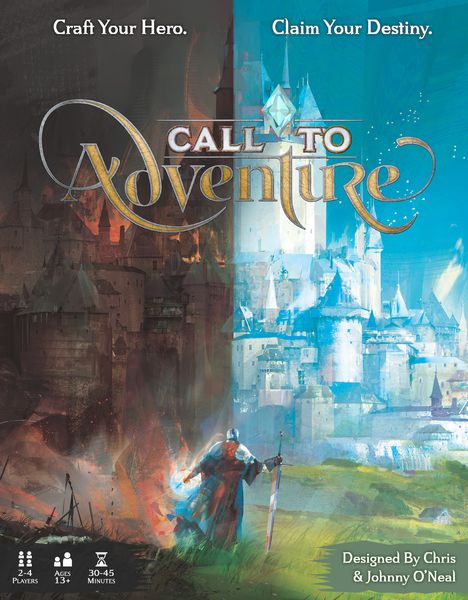
I recently received an email from Brotherwise Games asking me if I’d like to take a look at their latest creation, Call to Adventure. It had been funded on Kickstarter with almost 10,000 backers, and the game was getting ready for widespread release. I’ll admit that I hadn’t heard of this one before – and I did a quick glance of the KS campaign to learn more about it… What I found: “In Call to Adventure, players compete to create fantasy heroes. On the journey from your humble Origin to your epic Destiny, you will gain Traits, face Challenges, and grow in your Abilities. Every player will build a character and tell a story, but only one will become the greatest hero!”
I’ll admit that I’m not the biggest fan of story-telling games; in fact, I loathe them. But, this looked to be more than tale fabrication, and I was impressed with Unearth, an earlier release from this fledgling company, so I took the plunge and took a copy.
In this game, as the above synopsis explains, each player has a character that they try to develop over the course of the game. And, as you would expect, the character which has the best story (I mean, the one which scores the most victory points) will be declared the winner of the game!
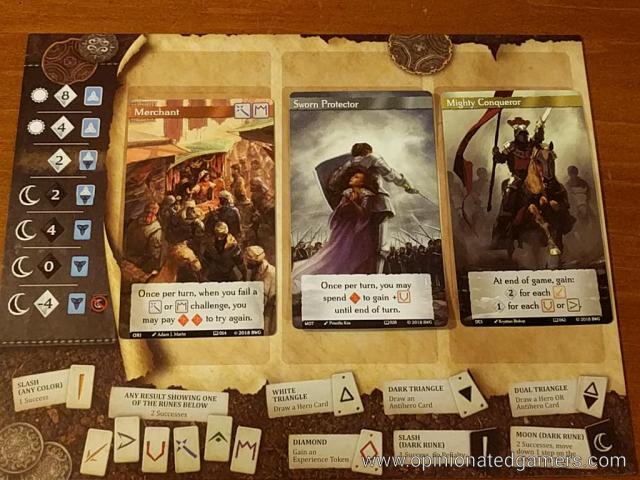
Just like in real life, everyone is different – people come from different backgrounds and cultures, they have different formative experiences, and they have different goals. In Call to Adventure, this is also true. Each character has a player mat, and on that mat you will place an Origin card, a Motivation card and a Destiny card. Unlike real life, you are dealt two of each type of card and you get to choose one of each category. The Origin and Motivation cards are placed face up, while the Destiny card is face down. Sure, this makes it harder to know what your Destiny is… however, unlike real life, you are allowed to look at Destiny card at any time to see what you’ll end up becoming (scratch that, what you’ll end up scoring Victory points for…). Each of these cards have some rune icons in the title bar, and many of them have a special rule/ability printed in the text box area. These cards tell the story of your character, and as you go through the game, you will add more cards to your board, thus fleshing out the story of your character.
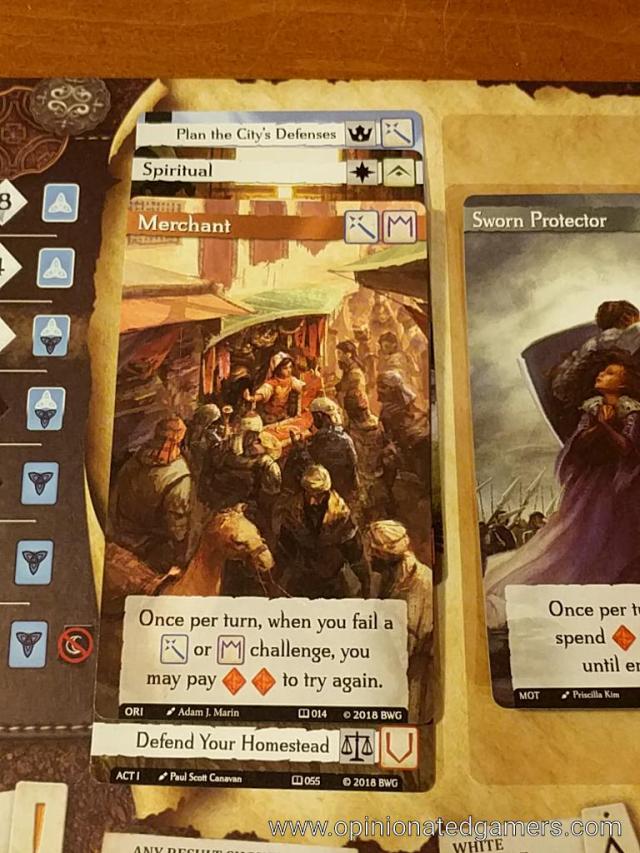
On the left of your player board is your Corruption scale. You start in a neutral position, but you can move up and down on this scale depending on how you collect Virtue or Corruption throughout the game. Depending on your position on this scale, you will be able to play Hero cards (white), Antihero cards (black) or either type. At the bottom of your player mat, you will find a handy player aid of what the different icons in the game represent. The possible avenues of the characters’ stories are laid out in a grid on the table; five cards for each of the three Acts are laid out. At the start of the game, only the Act I cards are face up. A start player is chosen, and players take turns until the game end is triggered – when one player has placed their third card underneath their Destiny card.
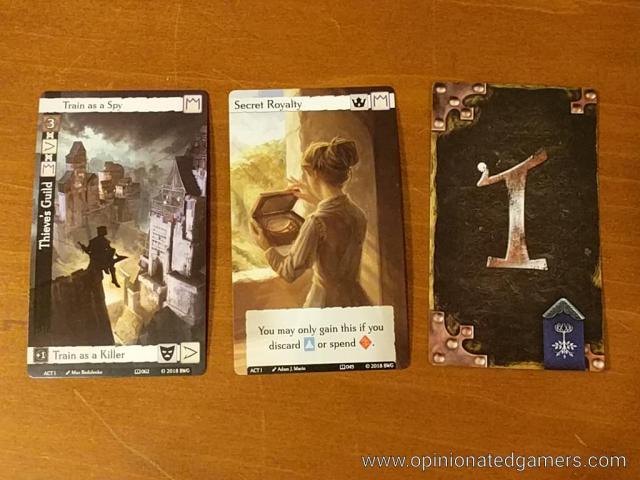
On a player’s turn, the main choice is to try to gain a Trait or defeat a Challenge. Both of these types of cards are what you will find in the story tableau in the center of the table. Challenges have a title bar going down the long edge of the card which tells you what the challenge is; there are also two different titles on the short edges of the card which give you two options on how you can overcome this particular challenge. The Trait cards simply have a title bar at the top of the card and then a condition for acquisition in the bottom text box. You are allowed to try to gain any card which is face up in the tableau (more on how to expose more cards later). If you don’t like your selection of cards, once a turn, you can spend an Experience marker to discard one card from the tableau and replace it was a card from the appropriate deck. At the start of the game, you can only see the Act I cards.
If you want to gain a trait – you simply see if you qualify to take the card. You may have to discard something to pick up the trait. You might simply have to possess some other quality (or perhaps NOT possess something) in order to get the card. Whenever you gain a card, you put it under the leftmost available card (Origin first, then Motivation, then Destiny). An Act of your character’s life is complete when it has three cards under it…
If you want to gain a Challenge card, the process is a little more complex. First, you designate which challenge card you want to try to gain, and you also declare which path you will try to use to defeat it (top or bottom). The general difficulty of the task is seen in the number in the vertical bar, and the rune icons seen under the strength tell you which ability runes can also be used. This difficulty can be modified by “+1” modifiers that you might see on the different paths. Now, you pick up the runes that you will cast – you always take the three white core runes. You also look at the cards on your player board, and you take matching ability runes as seen on your cards if the challenge uses those particular abilities. Finally, you can choose to spend experience tokens (up to 3) to add a Dark Rune to your hand for each spent.
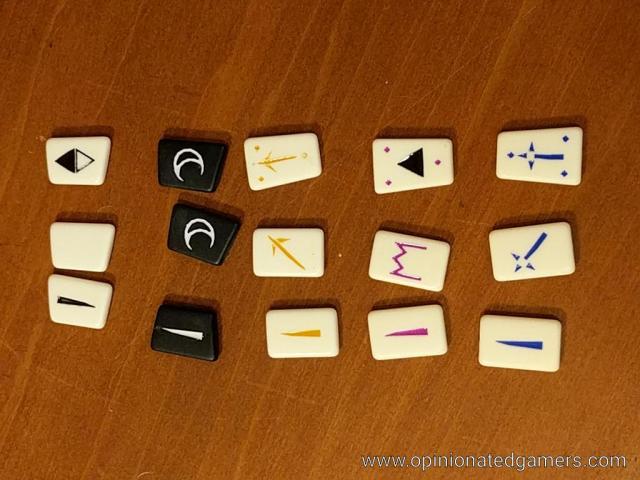
The runes are really nice looking d2. When you cast the runes, you throw them on the table, and then you look at the icons which are face up on them… The core runes add 0 or 1 to your throw, and sometimes they will allow you to draw a Hero or Antihero card. The ability runes are better for the result, and they add either 1 or 2 to the value of your strength. There are special runes of each type which either add 2 or give a fairly decent special action – but you can only use these runes if you have three icons in that ability. Finally, the Dark runes are a high risk/reward proposition. You either add 1 or 2 to your strength, but if you add 2, you end up being corrupted, and you have to move down the corruption scale.
Anyways, back to the challenge – before you throw them bones, you can one final chance to increase your chances. You can apply any effects from Hero and Antihero cards that you are able to play – be sure to check your current place on the Corruption track to see which type(s) you are allowed to play at the moment! Now, cast the runes and count up your strength. If you meet or exceed target number, you succeed and you take the card from the table and place it underneath your leftmost available starting card. Place the challenge card so that you can read the title of the path choice you took. You now gain any abilities or icons seen on that title bar. If you fail at the challenge, discard the card from the tableau and take an Experience token from the supply as your consolation. In either event, replace the card with the top one from the appropriate deck.
In addition to the main action of trying to gain a Trait or a Challenge card, you can also take optional actions whenever the time is right on your turn. You can play a Hero or Antihero card – the timing of each of these is usually specified on the card itself. You can also use effects from your Origin or Motivation cards if you meet the criteria on them.
If you manage to place a third card (Trait or Challenge) underneath your current Act card, you close that chapter of your life and you move on. At the start of your next turn, if they are not already visible, you then reveal the cards of the next Act on the tableau. From this point onwards, ALL players can try to collect any visible card. The game continues until a player places his third card underneath his Destiny card – thus having added nine cards to the story of his character’s life. At this point, each other player gets one more turn and then the game moves into the scoring phase.
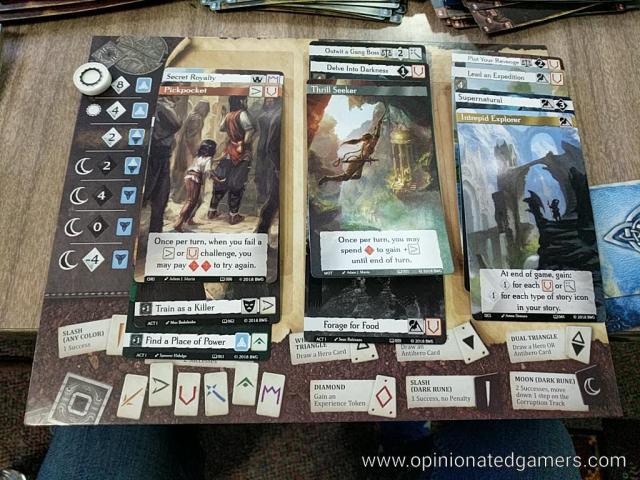
To start the scoring phase, each player first flips over their Destiny card and reveals the scoring rubric on them. Then add up your points:
- Look at the cards visible under your character cards and sum up all Triumph (white diamond) and Tragedy points (black diamond)
- Gain one point for each unspent Experience token
- One point for each Hero and Anti Hero card played
- Score points for your Story icons (for each type: 2/4/8 VPs for 2/3/4+ icons)
- Score points based on your position on the Corruption track
- Score points based on your Destiny card
The player with the most points wins the game. Before the game ends, the rules tell you to allow each player to tell the story of their character using the title bars seen on the cards on their player board.
There are also ways to play the game – including Solo and Cooperative rules. The competitive game can also be made more complex with the addition of Ally and Adversary cards. However, I haven’t had a chance to play any of these forms, so all I can do right now is report that these options exist.
My thoughts on the game
Well, I’m glad to report that this isn’t a story telling game at all. It’s a bit of dice rolling, a smattering of set collection, a smidge of engine building and a pinch of tactical card management. When I initially read the KS campaign, I feared that this would be more of a storytelling game, when in reality, it’s a cleverly disguised Euro-game.
My group is not one for telling stories, and we pretty much ignored that facet of the game entirely. For us, it was not necessary to construct the story of our people. However, I can definitely see that more imaginative folks will enjoy generating the backstory behind their Orphan Pickpocket who first made it thru a Cruel winter by Foraging for Food. Then, he answered the Call to arms by Enlisting in the King’s Army. Thus ended the first act of his life… But, for me – that just feels like a lot of work to come up with that. To each his own, I suppose! I’m just as happy to play the game to collect cards and VPs and not deal with the story telling at all.
The Anti-hero cards can be a little bit take-that, but not so much that they will alienate anyone… but they can really be a bit annoying at times. For a thematic game, this sort of thing is de rigueur but I could personally take or leave it. If there were an option to not have them in the game, I’d leave them out – but it is what it is.
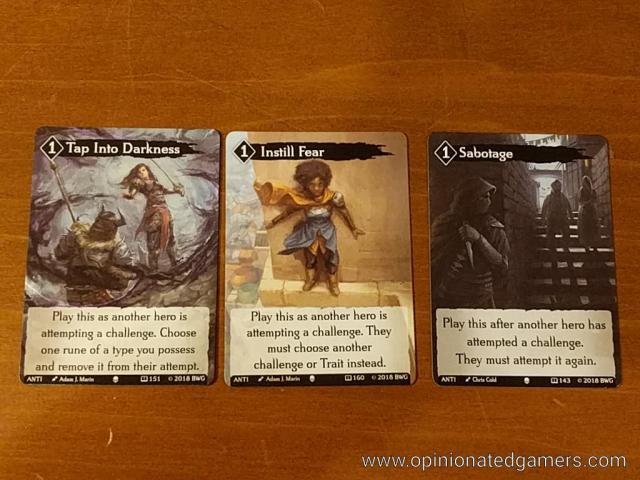

I like the way that the game gives you the decision point of collecting Trait cards – this is a low risk move which strengthens your character – proving extra ability icons to use in the future. However, the rewards are often not as great as those found on the Challenge cards – and players will have to decide how they want to progress through the tableau and develop their character’s story. There is a little bit of engine building as you will try to manage which Ability icons you have on your cards to help you gain future cards. Be sure to keep an eye out for the story icons – the bonus for having multiples of story icon types can often be the difference at the end of the game.
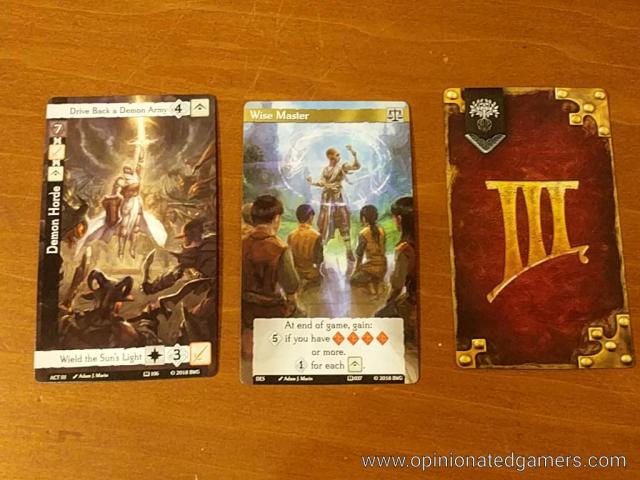
The artwork is very nice, and the artwork on each card really helps add to the story building theme. Like other games with multiple cards such as Magic: The Gathering and Dominion – there are a number of different artists used in the game, and you’ll surely find a few cards which are your favorite as the colors and style of the art of that particular card just catch your eye.
The cardstock is thin, but in a game where the cards are shuffled only once and are not really handled much, they are perfectly appropriate. The runes have a nice heft in the hand, and a little bit of fooling around (dropping them from arm’s length on the table) shows them to be pretty fair as far as evenness of result. The storage tray is also thin, but it provides a nice way to arrange the cards for storage as well as providing a removable tray which can be used to keep the runes on the table for all players to reach.
The game itself plays quickly. When you break it down, the game ends after the first player has collected nine cards to add to his story, and each individual turn doesn’t last very long. Player interaction is only indirect – competition for the cards in the tableau – so you can spend most of your downtime studying the cards in the tableau, getting ready for your turn. Our first game took 75 minutes, but this included rules and a bit of slow play as we tried to get used to the flow of the game. My second game was much faster, and I can definitely see this playing in about 10-15 minutes per player if everyone is familiar with it.
Call to Adventure is a nice light game that I look forward to exploring further. Don’t be scared away from it because it has been described as a story telling game because that’s simply a tall tale – it’s a nice Eurogame.
Until your next appointment,
The Gaming Doctor

Pingback: Best New (To Me!) Games of 2019 | The Opinionated Gamers
Pingback: Greatest New (To Me!) Video games of 2019 - Best Games 2020